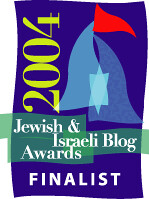"GATES" AND JUDAISM
In this article in the Forward (free registration may be required to read the story, but copious excerpts are available here), there is a discussion of the Jewish meaning that can be applied to the famous "Gates" installation in Central Park.
A few hours after the installation's inauguration, Michael Strassfeld, a rabbi whose congregation meets just a few short steps from the celebrated 16-day installation, brought together a group of some 70 of his congregants for a Sabbath-afternoon talk on the place of the gate in Jewish thought. Traditionally, explained the rabbi, the city gate is where the action is: where one goes for news, for trade. It is where justice is administered.
Whenever anyone mentions gates in the context of Jewish life, I think of several things: the synagogue I've attended for ten years (Shaarei Zedek--Gates of Righteousness), the gates of Jerusalem, and the synagogue I tell people I'm going to when I'm really just sleeping in (Shaarei Sheinah--Gates of Sleep).
The gate is no less central in the relationship between man and God. One need think only of the gates of prayer, the gates of repentance. The closing portion of the Yom Kippur liturgy, the Ne'ilah service, which centers on the closing of the heavenly gates, is regarded as the penitent's last chance at redemption. The gate is the threshold between the known and the unknown, past and future. It's a place of risk, where demons lurk; it's where one hangs the mezuzah.
This threshhold thing reminds me of an episode of Charmed, wherein a little girl was scared of doorways and windows because that's where gremlins lived. I keep waiting for Makor to offer a class in Jewish demonology, 'cause I'll be so there. Especially if we talk about Lilith as the progenitrice of BTVS's vengeance demon, Anya.
Wrappings and coverings constitute an astounding number of Judaism's ritual objects: the curtain for the Holy Ark, the prayer shawl, the wedding canopy, the kittel prayer robe — each endowing what it covers with ceremonial uniqueness. And such, some say, has been the effect of the Gates' billowing fabric on visitors in Central Park.
I'm going to go on record: I really wish the fabric were a different color. Which color would I prefer? I don't know. I'm no artist. The orange (or as the Christos like to call it, "saffron") throws me into a visual panic. It looks like there are hazard cones all around the park, outlining it as one big Law and Order crime scene, or creating the effect that Central Park is experiencing an "orange" level of terror threat.
Or maybe that's just my own internal terror alert system.


0 Comments:
Post a Comment
<< Home